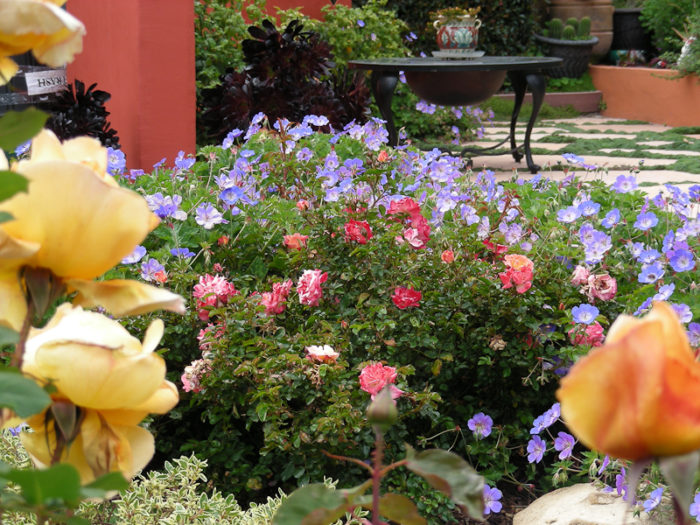
In the past year, lots of people have started breathing easier about their financial situations. Hopefully, you’re one of them. They’re sticking their toes into the real estate pool. (The daring ones are cannonballing off the high dive.) If you’re a garden lover and shopping for a home – whether to expand your living space, down-size or because you’re relocating to a new community – bear in mind that you’re not just buying lumber, stucco and shingles.
If there’s any outdoor living space within your property lines, you’re also buying a yard, be it a postage stamp or some serious acreage. And there’s a good chance that not everything in the sellers garden suits your taste and lifestyle, so it’s helpful to consider what’s an easy fix and what might give you pause for thought.
In a previous two-part blog, I offered tips to sellers on how to make their house and garden more appealing to potential buyers. Now it’s time to share a few tips for shoppers.
The Limits of Curb Appeal
Smart sellers go to great lengths to make a good first impression with a splash of color or burst of drama as curb appeal. That’s well and good, but pay attention to whether that same level of care extends to the rest of the yard. Keep a sharp eye for areas of the garden that will need extensive investments of time and money to bring them up to your standards.

And plants that were recently added to fill bare spaces might be packed too tightly for the long-term good of your garden, requiring you to relocate or completely remove them to avoid a horticultural pile-up.
Spaces for Living – Do a “Needs Assessment”
It’s my firm believe that first and foremost, yards should provide spaces for activities like family dinners, entertaining guests, safe play for kids and pets, or just somewhere to lose yourself in a trashy paperback. As you explore the garden on open-house day, imagine a year in the life of your family and how you’d live in this garden. Space limitations and the cost of constructing patios and get-aways can add up fast.

Now dig a little deeper and consider how comfortable the existing spaces will be. If you’re a shade lover but the dining terrace gets blasted by afternoon summer sun, you might not feel compelled to take advantage of an otherwise accommodating spot.
Some Things You Can’t Change – Site Analysis Basics
And speaking of sun, before taking off on your open house cruise, use your computer’s search engine or smart phone GPS to figure out the orientation of the property so you can better understand sun patterns. These will affect not only your comfort but also which plants will be happiest around the property. Ask the current owners where pleasant breezes come from and where the cold winter winds originate. (Look at the shape of mature trees for clues about prevailing winds.) And if you’re in a new community, find an experienced person at the local garden center to explain unfamiliar climate conditions that might affect your garden.

A few things you have less control over are soil and off-site views, good or bad. When it comes to the dirt under your feet, you can add amendment to the planting hole and use best management practices to improve drainage and fertility in your beds, but that takes time, money and a strong lower lumbar region. Maybe not on your first visit, but once a house makes your short list, consider doing a little digging (literally) to check for soil texture (clay, loamy, sandy) and perhaps even send off a sample for a lab test if the existing garden looks troubled.
If the house is blessed with good views, that’s great, but will they last? Are there young trees on neighboring properties that will grow up and spoil the fun? And what about the stuff you’d rather not look at: billboards, utility poles, and such. Is there enough space for screening plants? Can you “re-aim” your outdoor rooms to draw attention elsewhere? Pay attention to where your neighbor’s windows face and consider whether you’ll want to increase your privacy.
Stylistically speaking, my favorite gardens are those where the architectural style and garden support one another: Tudor house + cottage garden; Tuscan villa + Mediterranean garden; Neolithic man-cave + tundra. Ask yourself if the garden of your dreams would make aesthetic sense with the house you’re about to buy. If not, can you picture yourself undertaking a new garden that does work with the architecture?
Read on
Click through to Part 2 for tips about the practical side of gardens: hardscape, utilities and your safety. Part 3 show you how detect maintenance “black holes” and shares other cost-saving ideas.
Fine Gardening Recommended Products

A.M. Leonard Deluxe Soil Knife & Leather Sheath Combo
Fine Gardening receives a commission for items purchased through links on this site, including Amazon Associates and other affiliate advertising programs.


















Comments
I have been reading up on how landscaping can affect your bottom line, so I am trying to plant beautiful curb appeal before selling! Now that I am reading this though, you are right, it would be great to plan as a long term initiative
offcurse the garden is join with the house and when you purchase the house the garden is alson in your custordy but know its your resposibilty that manage the garden and maitain it its really a good hobby as well as healthy for health.
Evergreen Shrubs
yes i know this thing when you buy a home a garden is like your gift that your resposiblity to manage the garden and maintain its your responsibility as well as its healthy for you.
Evergreen Shrubs
Log in or create an account to post a comment.
Sign up Log in